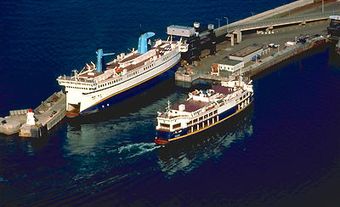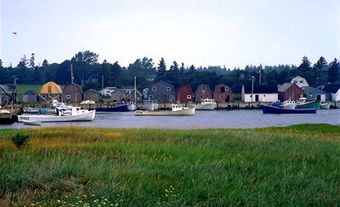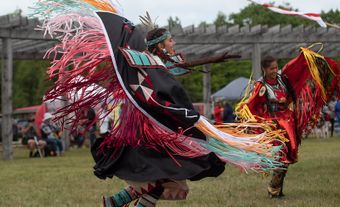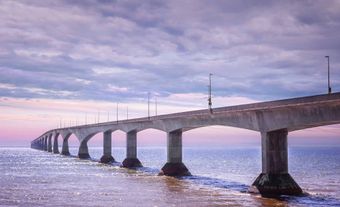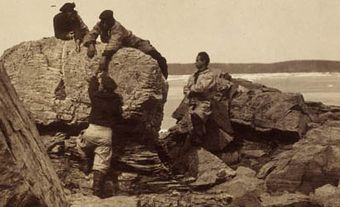Charlottetown, PEI, incorporated as a city in 1855, population 38,809 (2021 census), 36,094 (2016 census). The capital of Prince Edward Island, the City of Charlottetown is also the administrative centre of Queens County and the principal municipality of Canada's smallest province. It is situated on a broad harbour opening into the Northumberland Strait. Three rivers converge there, with the city located on a low-rising point of land between the Hillsborough (East) and North (Yorke) rivers just opposite the harbour's mouth. Suburban development has spread across the Hillsborough to Stratford, and between the North and West (Eliot) rivers at Cornwall. Besides its governmental functions, Charlottetown services a considerable agricultural hinterland and is the focus of Island communications. Its favourable climate, nearby beaches and claim to be the “Birthplace of Confederation” have made it a major tourist centre.
History
Indigenous Settlement
Early Indigenous peoples are known to have been on Prince Edward Island as early as 10,600 years ago. Around 2,000 years ago the Mi'kmaq established a presence there. Nomads, they would have frequented the Charlottetown area as the three rivers offered easy access to various parts of the Island. Abegweit, as the Mi'kmaq called Prince Edward Island, offered an abundance of food according to the season, including edible plants, large and small game, water fowl, eels, fish and shellfish, and marine mammals such as seals and walruses.
European Settlement
European settlement in the region dates back to 1720, when an expedition sent by the Comte de Saint-Pierre established itself west of the harbour's entrance at a site named Port La Joie. With the arrival of Europeans in the Maritimes, the Mi'kmaq became involved in the fur trade, which altered their traditional way of life and brought new, deadly diseases.
After the assumption of direct control of Île Saint-Jean (the Island's French name) by the French government in 1730, Port La Joie was retained as the administrative centre, even though other locations on the Island showed more commercial promise. This decision was confirmed by the British when they finally achieved mastery in the region following the capitulation of Louisbourg in July 1758. The arrival of British troops at Port La Joie the following month sealed the fate of its population as they, along with the rest of the French and Acadians on the Island, either fled or were rounded up and deported. (See History of Acadia).
The British then renamed the settlement Fort Amherst and strengthened its defences. In 1768, however, Charles Morris, chief surveyor of Nova Scotia, laid out a new town site across the harbour, and the community was christened Charlottetown, after Charlotte, wife of King George III. While the area was distant from the lucrative fisheries, it offered excellent transportation corridors to the interior via the rivers, and was close to Nova Scotia and a road to Halifax.
The original town plan provided for broad streets on a grid pattern, with the main axis running north from the Hillsborough River, a common for future expansion, and a royalty for pasturage and gardening. Sites were designated for a market house, church, courthouse and jail, but it was some time before all of these facilities were provided.
In 1769, the town's status was enhanced by a decision of the British government to separate St. John's Island (renamed Prince Edward Island in 1799) from Nova Scotia and to make the little community the capital of the new colony. The first governor, Walter Patterson, who arrived in Charlottetown in 1770, began establishing essential administrative services, but just as significantly commenced work on roads to more distant parts of the colony. As settlement of agricultural areas progressed, Charlottetown became a market town as well as a communications and administrative centre. These functions remain essential elements in the city's economy.
In 1775, Charlottetown was attacked by American privateers who looted homes, stole the colony’s official seal and kidnapped two government officials. In the aftermath, defence systems which had been constructed prior to the American Revolution were strengthened.
Development
In the 19th century, shipbuilding and ship owning were important elements in Charlottetown's economy, which was diversified somewhat by small-scale manufacturing such as tanning, brewing and shoe production. Shipbuilding in the city had virtually ended by 1870, though ships built elsewhere on the Island were still finished there and the port retained its importance as a distribution point. After 1880, the decline of shipbuilding elsewhere on Prince Edward Island and poor returns on shipping due to sluggish international trade undercut the local economy.
Charlottetown’s limited prosperity as well as residents’ vigorous opposition to taxes ensured thrift in the provision of community services. Improvements to counter fire and disease tended to follow disasters such as the Great Fire of 1866 or the smallpox epidemic of 1887. Nevertheless, by the end of the century, Charlottetown possessed modern water and sewer services, electric street lighting, proper hospitals and schools, and a varied cultural life.
Communications links, including coastal steamship service, the railway, and the telegraph and telephone, allowed the city to expand its influence over distant parts of the Island. They reinforced the economic interdependence between the city and rural areas, though communications difficulties with mainland centres of commerce continued to highlight Charlottetown's relative isolation.

The first in a series of conferences, which resulted in the creation of Canada in 1867, was held in Charlottetown in 1864. Prince Edward Island, however, did not join Confederation until 1873, but as a result of the Charlottetown Conference , the city today claims the title the “Birthplace of Confederation.”
Tourism, an increasingly important part of Charlottetown's economy, was stimulated by the opening of a major railway hotel in 1931 and further encouraged by motel construction in the 1950s and 1960s, and more recently by new hotels and a convention centre. Much of Charlottetown's tourist industry is based on the city's role in Confederation. The province, municipality and private interests have collaborated to promote the “Cradle of Confederation” theme, thereby encouraging tourism and local economic development. Founders' Hall, created in a heritage railway car shop as a Millennium Project and billed as “Canada's Birthplace Pavilion,” told Canada's story from 1864 to the present. For the 150th anniversary of the Charlottetown Conference in 2014, a yearlong series of events was held in recognition of the city as the “Birthplace of Confederation.”
Cityscape
Charlottetown today is a city of contrasts. A market-town atmosphere exists beside extensive cultural facilities, large government offices and two institutions of higher education — Holland College and the University of Prince Edward Island. Expansive suburbs with modern shopping malls are strikingly dissimilar to "Old Charlottetown," the well-preserved downtown core.
The city remains richly endowed with stately historic mansions, such as Beaconsfield, now fully restored as a heritage site and headquarters of the PEI Museum and Heritage Foundation, and pleasing 19th-century streetscapes like Victoria Row and Great George Street. Historically significant public buildings include the Victorian city hall, the classical revival legislature known as Province House and the Georgian Government House.
Victoria Park, 40 acres of land gifted to the city by the federal government in 1875, is located near downtown Charlottetown overlooking the harbour. This leafy site sits adjacent to the lieutenant-governor’s property and is a popular recreation area for city residents.
There are several outstanding examples of church architecture, the most striking of which are St Dunstan's Roman Catholic Basilica with its soaring towers and the exquisite All Souls Chapel of St. Peter's Anglican Cathedral, which is richly adorned with Robert Harris paintings. The Sir Louis Henry Davies Law Courts Building borders a harbourside redevelopment that includes homes, shops and offices. The opening of the Water Street Parkway, the creation of a shopping area on Peake’s Wharf and a spacious park at Confederation Landing in the late 1990s transformed the adjacent industrial land. Care has been taken to ensure that improvements such as these and the downtown Confederation Court Mall echo the city's built heritage while helping to maintain a vibrant urban core.
Population
Throughout the 19th century Charlottetown’s population averaged about 9 per cent of the Island’s total and grew as the Island grew. Most settlers were of English, Scottish or Irish origin, with a sizable Acadian element and smaller numbers of other ethnic groups, but by 1848 over half of the population were native-born Islanders. When Prince Edward Island entered Confederation in 1873, Charlottetown was the 11th-largest city in Canada.
In the 20th century the population of Charlottetown and its environs grew steadily as part of the Island’s total, but it failed to keep pace with massive urban growth in the rest of Canada. The city’s population decreased by about 3 per cent from 1976 to 1991, but in the same period the metropolitan area population grew by 38.5 per cent. In April 1995, an amalgamation of the city with six surrounding towns (West Royalty, East Royalty, Sherwood, Parkdale, Hillsborough Park and Winsloe) and the lands of the Queen Elizabeth Hospital increased the size of the city by more than six times and doubled its population. The process of urban sprawl, however, was not contained, and in 2021 the population of the Charlottetown census agglomeration was nearly double that of the city itself (78,858).
According to the 2021 census, people citing Scottish origins make up the largest ethnic group, at 31 per cent of the city’s population, followed by Irish (27 per cent) and English (21 per cent). Visible minorities account for 21.8 per cent of city residents, with Chinese, South Asian, Black and Arab people comprising the largest communities within this group.
Economy and Labour Force
Many 19th-century industries, including shipbuilding, have disappeared. In their stead are plants processing fish and seafood, beverages, dairy and meat products, and manufacturing a variety of metal products. The city is also home to new biotechnology and information technology industries. Outbound agricultural produce and imported petroleum products move through the city’s port.
Although government investment and partnerships have turned the biotechnology and information technology industries into two of the fastest growing sectors in the city, as the political and administrative centre of the province, a large portion of Charlottetown’s residents are employed in public administration. Other major industries include health care and social assistance, retail, accommodation and food services, and education.
Transportation
A special air mail service set up for the winter of 1929–30 demonstrated the potential of air travel as an alternative to the existing connections between Charlottetown and the mainland by steamer, railway and car ferry. After 1932 regular air service to Moncton, New Brunswick flew out of Upton Field to the northwest of the city. Limited capacity at this site and the need for unemployment relief prompted the city in 1938 to begin the construction of a larger municipal airport on a 300-acre parcel of land to the north of Charlottetown. By the early 1940s it had become the centre of a network of routes served by locally-based Maritime Central Airways. Facilities were vastly expanded by the federal government during the Second World War and used by the Royal Air Force for the British Commonwealth Air Training Plan, and then by the RCAF as an air navigational school. After the war improvements were made at various times by the federal department of transport until 1999 when management of the airport was turned over to the Charlottetown Airport Authority Inc.
Better roads on the Island encouraged automobile and bus travel, and undercut the economic viability of passenger rail service, which was ended in 1969. Trucks had the same damaging effect on railway freight, and 20 years later the railway on the Island was abandoned completely. The “fixed link” or Confederation Bridge, spanning the Northumberland Strait between Prince Edward Island and New Brunswick was opened in 1997. This, the world's longest bridge over ice-covered water, substantially mitigated Charlottetown's remoteness from other Canadian centres. Within the city, the car was also king, and public transport was largely absent until 2005 when an innovative public-private partnership succeeded in establishing a viable bus service.
Communications
In recent decades the city has increased its sway over the province's communications. The Guardian is Charlottetown’s daily newspaper, which has been in operation since the 1870s. A number of small local publishers, including Acorn Press, Retromedia Publishing, Bunim and Bannigan Ltd., and St. Peter Publications issue works of literature, poetry, theology and history. The Prince Edward Island Museum and Heritage Foundation, and Island Studies Press publish material that focuses on the province.
Government and Politics

Before incorporation of the city in 1855, government consisted of the colonial administration, volunteer organizations and individual citizens. Incorporation was prompted by the need to improve the physical services and by two external events: the achievement of responsible government on the Island in 1851 and the end of the Crimean War in 1854, which led to the departure of the garrison of British regular soldiers who preserved law and order. The city was divided into five wards, each of which elected two members to a Common Council that was headed by a mayor.
In the years since incorporation the term of office and the number of councillors were altered but the essential structure of government remained stable until the annexation of Spring Park in 1958. The growth of suburban communities, such as Sherwood and Parkdale, presented administrative challenges that were addressed by the 1995 amalgamation. Council now consists of a mayor and 10 councillors, each representing one of the city's 10 wards, with elections held every four years.
Several mayors left their marks on the community. Thomas H. Haviland (1857–67) held office for an exceptionally long period and set the tone for modest civic budgets. Lieutenant-Colonel J. David Stewart (1951–58) seized the opportunities of post-Second World War expansion to encourage development. Dorothy Corrigan (1968–71) was Charlottetown's first female mayor and the first to make the position a full-time job.
Cultural Life
The cultural life of the city continues to draw inspiration from the surrounding rural areas, creating a blend of urban taste and traditional values.
The city is home to many of the province’s designated National Historic Sites including Apothecaries Hall, Dundas Terrace, Charlottetown City Hall, All Souls Chapel, Ardgowan, St. Dunstan’s Roman Catholic Church, Government House, Fairholm, Great George Street Historic District and Confederation Centre of the Arts. Province House, opened in January 1847, is home to the Prince Edward Island Legislature. The former Legislative Council Chamber served as the meeting place for the Charlottetown Conference in 1864. Parks Canada and the Province of Prince Edward Island jointly maintain the site.
The Confederation Centre of the Arts was founded in 1964 as Canada's National Memorial to the Fathers of Confederation. The facility occupies a city block, the former Market Square, and is the home of the notable Charlottetown Festival. Anne of Green Gables–The Musical, Canada's longest running musical, has attracted millions of theatregoers to the Centre since 1965. The Centre also houses two well-known choirs, the Confederation Singers and the Confederation Centre Youth Chorus. Besides the theatre, the facility includes a library and an art gallery that is one of the largest such facilities in Atlantic Canada and boasts an exceptional collection of artwork by Robert Harris.
Charlottetown's annual social calendar is filled with outdoor festivals and concerts. For example, Old Home Week is a mid-summer celebration of the Island way of life. Well-known musicians from the city include singer-songwriter Nancy White, Patrick Reid, a jazz double bassist, and vocalists John Connolly, Dennis Ellsworth and Joey Kitson of the former Celtic rock group Rawlins Cross.
Charlottetown has been well represented in the elite of international sporting competition. William Halpenny (aka Happenny) won a bronze medal in pole-vaulting at the 1912 Olympics and David "Eli" MacEachern took the gold medal in bobsled at Nagano in 1998. In addition, Lorie Kane is one of Canada's most decorated female professional golfers. After a brief period in which the Ottawa Senators had a farm team in the city, the focus for hockey returned to the junior ranks with the current team being the Charlottetown Islanders of the Québec Major Junior Hockey League. The Charlottetown Driving Park is one of North America's premier tracks in harness racing. .

 Share on Facebook
Share on Facebook Share on X
Share on X Share by Email
Share by Email Share on Google Classroom
Share on Google Classroom



